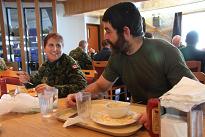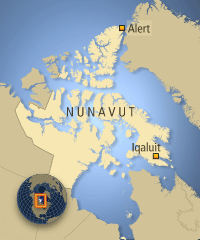Australian Adventurer Rescued in High Arctic
CFS ALERT – A Canadian search and rescue team plucked Australian adventurer Tom Smitheringale off an ice field in the High Arctic Thursday evening just six hours after receiving a distress call from his emergency locator transmitter.
 More photos of Tom Smitheringale
More photos of Tom Smitheringale
Tom Smitheringale, who was on a solo unsupported trek to the North Pole to raise funds for AIDS, malaria and tuberculosis research, fell through the ice on the 48th day of his journey.
“He is very lucky to be alive,” said Master Cpl. Jim Cooke, a search and rescue technician with the Canadian Forces. “In his condition he would not have lasted long. He was running on pure adrenaline.”
Cooke said Smitheringale had suffered frostbite to his fingers and toes but was able to walk on his own. Smitheringale admitted it was a close call, “I was certainly at the limit of my capabilities and there were times I thought I wouldn’t make it,” he said.
(Listen to Marc Montgomery’s conversation with
Australian Arctic adventurer Tom Smitheringale
on The Link)
POLARRESCUE_1445692.
By pure coincidence Canadian Forces were conducting their annual Arctic exercise, Op Nunalivut 10, in and around Alert. Maj. Steve Power, the commander of CFS Alert, said search and rescue technicians were training along Canadian Rangers near Ward Hunt Island and a civilian Sikorsky helicopter was also contracted to help and resupply the Ranger patrol, as well as a Canadian Forces Twin Otter airplane.
 As soon as Canadian officials received Smitheringale’s distress call, the helicopter, the Twin Otter and two search and rescue technicians were sent to his rescue.
As soon as Canadian officials received Smitheringale’s distress call, the helicopter, the Twin Otter and two search and rescue technicians were sent to his rescue.
Cooke and his colleague Master Cpl. Shane Best located Smitheringale on an ice pan about 200 km north of Canadian Forces Station Alert on the northernmost tip of Canada, on Ellesmere Island, Nunavut.
“He didn’t even come out of the tent until we landed,” said Larry Graham, one of the helicopter pilots. “But as soon as he stood up and gave us a thumbs up, I knew he was salvageable.”
Cooke said Smitheringale, a five-year veteran of the British Army, had stepped on a thin crust of snow formed by blowing winds over a crack in the ice. Smitheringale was strapped to his sleighs, which further complicated getting out of the water.
“He couldn’t get a grip and he swam from one edge of the crack to the other, trying to find a good way to get up,” Cooke said.
Above-average strength
 Finally after spending almost 10 minutes in frigid water with temperatures outside below -20 C, Smitheringale managed to pull himself up.
Finally after spending almost 10 minutes in frigid water with temperatures outside below -20 C, Smitheringale managed to pull himself up.
“Most people would have died after five minutes in that water,” Cooke said. “He is a person of above average strength and fitness.”
“He told us he thought he was done for,” Cooke said. “But he made one last ditch effort and managed to pull himself up.”
The ice was about six feet thick, Cooke said. Smitheringale managed to pull his sleighs across the crack, pitched a tent, lit his small gas stove, got into a wet sleeping bag, and activated the emergency locator transmitter, Cooke said.
 “He told us he had fuel just for one night,” Best added. “He had no dry clothes and no way of drying them, a few more hours and it would have been a very different rescue,” Cooke added.
“He told us he had fuel just for one night,” Best added. “He had no dry clothes and no way of drying them, a few more hours and it would have been a very different rescue,” Cooke added.
“I knew what I had to do and I did all the right things,” Smitheringale said. “I kind of kicked into autopilot. I kept my heart rate down and did not panic.”
“I knew if I can create a warm environment, get into dry gear, I might increase my chances of survival. That’s all I wanted to do.”
Smitheringale was taken to the CFS Alert where he was examined by medics, while staff scrambled to find dry clothing that would fit his 6’6 frame. At around midnight, looking tired but relieved Smitheringale sat in the common area for a hot meal that was prepared by the station cook especially for him.
More:
Tom Smitheringale Photo Gallery
External Link:
One Man Epic (A blog on Tom Smitheringale)
www.onemanepic.com



